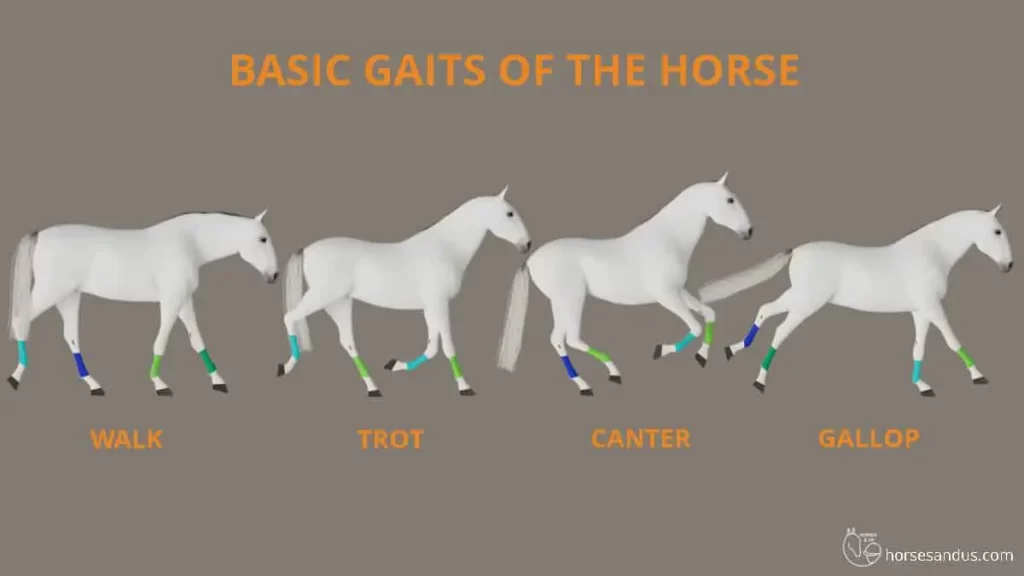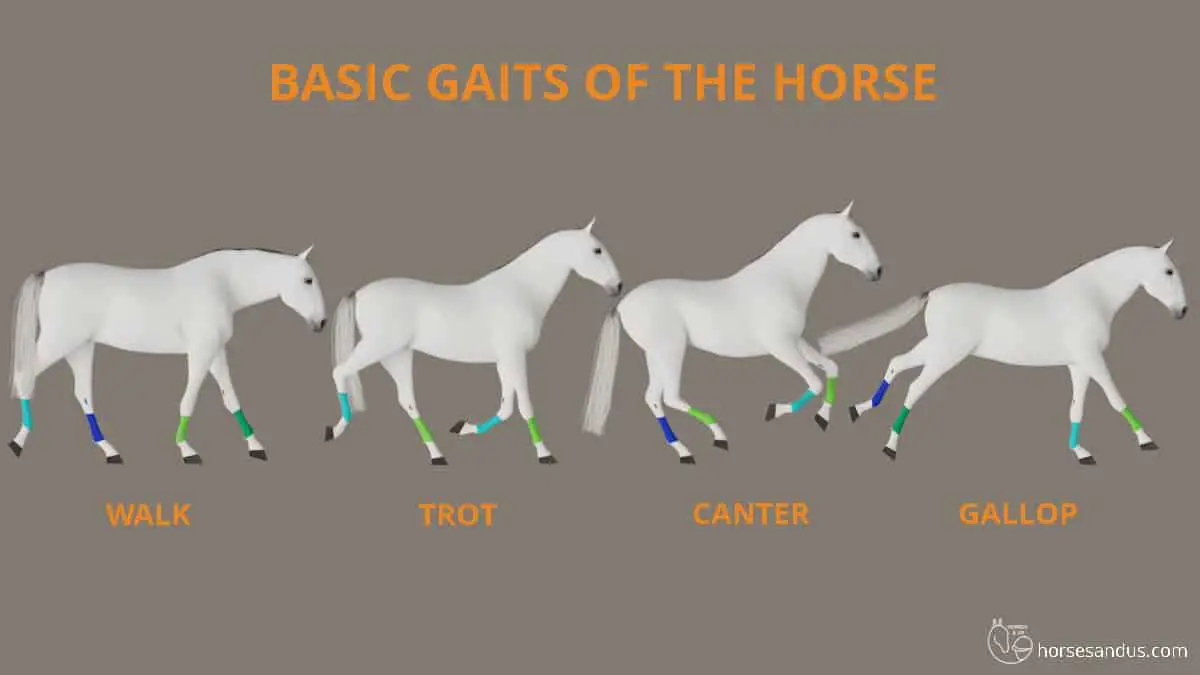Have you ever wondered about the different gaits of horseback riding? You know, those graceful movements that horses make when you’re up on their backs? Well, I’m here to tell you all about it! In this article, you’ll learn about the different gaits that horses can do and what each one means. It’s like learning a whole new language of horse communication! So, let’s dive into the exciting world of horseback riding gaits!
Firstly, you’ve got the walk. It’s the slow and steady gait that horses use when they’re just casually strolling along. It’s a four-beat gait, which means that each hoof hits the ground separately. You’ll probably find yourself bobbing up and down in the saddle as the horse walks, but don’t worry, it’s all part of the experience! Next up, we’ve got the trot. This is a two-beat gait where diagonally opposite legs move together. It’s a bit faster than the walk, so hold on tight! And that’s just the beginning! In the upcoming article on my website “http://horsebackridingdude.com”, I’ll be diving deeper into the gallop, canter, and other exciting horseback riding gaits. So, stay tuned for more horsey knowledge coming your way!

Understanding Horseback Riding Gaits
Horseback riding is a beloved hobby for many, providing an exhilarating experience of freedom and connection with these magnificent creatures. But to truly enjoy the ride and communicate effectively with your horse, it is crucial to understand the different gaits they exhibit. In this article, we will delve into the world of horse gaits, from the basic to the advanced, and explore the factors that can influence their execution.
What are Gaits in Horseback Riding?
Gaits refer to the distinct patterns of movement that a horse exhibits while walking, trotting, cantering, or galloping. Each gait has its own unique rhythm and footfall pattern. Familiarizing yourself with these gaits will not only enhance your understanding of your horse’s natural movements but also enable you to communicate effectively with your equine partner during rides.
Importance of Understanding Horseback Riding Gaits
Understanding horse gaits is essential for several reasons. Firstly, it allows you to assess the horse’s physical condition, as irregularities in gaits may indicate underlying health issues. Additionally, knowing the different gaits helps you choose the appropriate gait for specific activities, such as trail riding, dressage, or jumping. Furthermore, understanding horse gaits enables you to communicate more effectively with your horse, ensuring a smoother and more enjoyable ride for both of you.
Basic Horse Gaits
1. Walk
The walk is the most basic gait and the one in which horses spend most of their time. In the walk, the horse moves forward by placing one foot at a time, creating a four-beat rhythm. This gait is comfortable for riders and is often the preferred gait for trail rides or relaxed outings.
2. Trot
One of the most common gaits in horseback riding is the trot. It is a two-beat gait where the horse’s diagonal pair of legs move together. The trot can have various speeds, including the working trot, collected trot, and extended trot. Riders need to develop a good sitting trot to maintain balance and rhythm while riding.
3. Canter
The canter, or lope, is a three-beat gait that combines elegance and speed. It is a favorite gait for equestrians as it allows for a smooth and thrilling ride. During the canter, the horse’s feet move in a specific sequence: outside hind, inside hind and outside front together, and inside front. It is important to learn the proper aids and cues for transitioning into and maintaining the canter.
4. Gallop
The gallop is the fastest gait, often associated with wild horses running freely across open fields. It is a four-beat gait where all four feet are off the ground during specific moments of the stride. The gallop provides exhilaration and speed, making it suitable for activities such as racing or cross-country riding.
Advanced Horse Gaits
While the basic gaits are the foundation of horseback riding, advanced riders may also explore more specialized and expressive gaits.
5. Piaffe
The piaffe is a highly collected trot performed in place. It is a demanding gait that requires intense engagement of the horse’s hindquarters and a high degree of collection. The piaffe demonstrates the horse’s strength and agility and is often seen in dressage competitions.
6. Passage
Similar to the piaffe, the passage is another collected gait seen in dressage. It is a slow, elevated trot with pronounced suspension, showcasing the horse’s impeccable balance and rhythm. The passage is often executed with precision and elegance, displaying the horse’s advanced training.
7. Flying Changes
Flying changes involve smoothly transitioning from one canter lead to another mid-stride. This advanced maneuver requires precise cues and coordination between horse and rider. Flying changes are commonly seen in high-level dressage tests and showjumping courses.
Differentiating between Horse Gaits
Distinguishing between horse gaits can sometimes be challenging, especially for beginners. The key lies in observing and feeling the rhythm and footfall pattern of each gait. Walking has a four-beat rhythm, trotting has a two-beat rhythm, cantering has a three-beat rhythm, and galloping has a four-beat pattern during specific moments. Regular practice and guidance from an experienced instructor will help you develop your sensory perception to differentiate between these gaits effectively.
Factors Affecting Horse Gaits
Several factors can impact how a horse executes its gaits:
-
Breed: Different horse breeds have their own specific natural movements, which can influence their gaits. For example, gaited breeds like the Paso Fino or Icelandic horse have additional intermediate gaits.
-
Training and Conditioning: A well-trained and conditioned horse will exhibit smoother and more controlled gaits compared to an untrained or unfit horse. Regular exercise, correct riding techniques, and consistent training contribute to the development of balanced and coordinated movements.
-
Terrain: The type of ground or terrain on which a horse is moving can affect its gaits. Uneven surfaces, slippery paths, or challenging obstacles can alter the horse’s natural rhythm and footfall pattern.
-
Rider Influence: The rider’s position, aids, and cues can greatly influence how the horse moves. Clear and consistent communication between rider and horse is essential for maintaining and transitioning between gaits smoothly.
Conclusion
Understanding horseback riding gaits is essential for any equestrian enthusiast. By familiarizing yourself with the basic gaits – walk, trot, canter, and gallop – and exploring more advanced gaits like piaffe, passage, and flying changes, you deepen your connection with these majestic animals. Learning to differentiate between the gaits and recognizing the factors that affect their execution allows for better communication and a more enjoyable riding experience. So hop on your horse, feel the rhythm, and let the gaits carry you on an incredible journey of horsemanship and connection.
References:
- “The Basics of Riding Gaits – Walk, Trot, Canter, Gallop” – Horse Illustrated
- “Understanding Horse Gaits” – Equitrekking
- “What Are the Different Horse Gaits?” – The Spruce Pets
